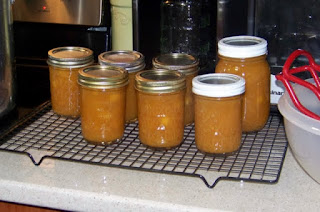If only these were the kind of mudslides mother nature sent to wreak havoc on our world! Divine, chewy cookies with not one, not two but THREE types of chocolate. Ooooo la la! The only victims these mudslides may have are your waistline (that is if you eat too many, which is really easy to do)! I got this recipe from one of my favorite websites, http://www.marthastewart.com/.
The three types of chocolate used in these cookies are unsweetened, semi-sweet and milk chocolate. The picture on the right shows all three chocolates together. If you look closely (no drooling please) you can see differences in how dark the different chocolates are. To the left is milk chocolate, the one that is lightest brown in color. In the middle is unsweetened chocolate (dark brown blocks) and to the right is semi-sweet. I like to view chocolate (the types used in baking) as a spectrum. At one end is unsweetened, essentially raw, chocolate and at the other end is milk chocolate. In-between the two is semi-sweet and bittersweet chocolate. I'm sure most of you know that there are distinct flavor differences between these types of chocolate as well. So what accounts for the differences in flavor and color as you progress through the "chocolate spectrum?" Well, in case you didn't know....
Chocolate comes from cacao trees grown in tropical climates around the world. Cocoa beans are the seeds found inside of the fruit of cacao trees. The raw beans have a very bitter and intense flavor to them. After fermentation, the beans go through a variety of processes involving roasting and hulling. The hulling separates the shell from the nib which is the part of the bean used to make chocolate liquor. Chocolate liquor is the primary component of unsweetened chocolate. It is raw, minimally processed chocolate: grounded nibs from roasted cocoa beans. Thats why if you've ever tasted unsweetened chocolate by itself, you probably didn't like it much. It was probably very bitter and over-powering.
In fact, the word chocolate is derived from a Nahuatl (an ancient Aztec language, I believe it is pronounced nah-waddle) word that meant "bitter water." The other types of chocolate such as semi-sweet and bittersweet are made by combining chocolate liquor with varying amounts of sugar, cocoa butter (a vegetable fat from the cocoa bean and yes its like whats used to help heal those nasty stretch marks), and sometimes vanilla extract. As you might have guessed bittersweet chocolate has less sugar and more chocolate liquor (raw cocoa) in it, thus giving it a more bitter flavor." Milk chocolate, obviously, has milk added to it. This is why it has a lighter color and more mild, sweeter flavor. For more information on the from-tree-to-cookies chocolate process, I recommend the following Hersey's website: http://www.hersheys.com/discover/chocolate.asp
So now we've taken our journey through the chocolate spectrum. Back to our cookies. The unsweetened, semi-sweet and milk chocolate flavors blend together to create a rich chocolatey taste that is "OUT OF THIS WORLD" as friend described them. The first step in making these cookies is to combine the unsweetened and semi-sweet chocolate and melt them over a double boiler.
As usual when melting chocolate be sure not to crank the heat up too high and to stir frequently to avoid scalding the chocolate. You also don't want the heat so high that the water boils and steam starts seeping through the sides of your bowl. If ANY water comes in contact with the chocolate, it will get lumpy and curdley...yuck! In the mean time, you are to beat the eggs, sugar and vanilla. It should look light and fluffy. Next you add the melted, COOLED chocolate. Its important to cool the chocolate. If you add it into the eggs when the chocolate is too hot, you could end up with scrambled eggs. I've never had chocolate scrambled eggs but I'm guessing its not very appetizing... Once those are combined you slowly mix in the flour and then finally the milk chocolate. Saving the milk chocolate and adding it last ensures that the cookies have chocolate "chunks" in them. YUMMY! Then you just scoop and bake! Here's a tip: the recipe calls to bake these at 400. I believe that is too high, at least it is for my oven. I recommend 350-375 to prevent burning on the bottom. These make great chocolatey treats for your friends, family and co-workers for Valentine's day! Make them yourself or if you don't have time- don't forget I take orders! Happy baking!





















